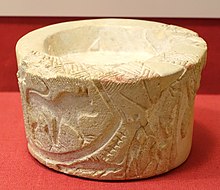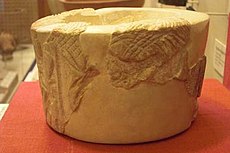Qustul
 | |
| Location | Aswan Governorate, Egypt |
|---|---|
| Region | Nubia |
| Coordinates | 22°14′0″N 31°37′0″E / 22.23333°N 31.61667°E |
| Type | Archaeological site |
Qustul is an archaeological cemetery located on the eastern bank of the Nile in Lower Nubia, just opposite of Ballana near the Sudan frontier. The site has archaeological records from the A-Group culture, the New Kingdom of Egypt and the X-Group culture.
A-Group records
Three significant A-group culture cemeteries of the times of the First Dynasty of Egypt have been excavated, which is located in present-day Egypt what was once Lower Nubia at least 5800 years ago. The most important one, cemetery L, revealed wealthy burials of rulers. In one of these graves was found an incense burner believed by Bruce Williams of the Oriental Institute at the University of Chicago depicting images assigned to the Pharaoh including a shape of the White Crown of Upper Egypt.[1]
Bruce Williams argued in 1987 that his discovery of the Qutsul incense burner advanced no claim of a Nubian origin or genesis for the pharaonic monarchy but that the archaeological data shows Nubian linkages and influence in helping to "fashion pharaonic civilization", including detailed excavations of the burial place of the Nubian rulers with date stamps well before the historical First Dynasty of Egypt. The size and wealth of the tombs were also described as vastly greater than that of the well-known Abydos tombs in Egypt.[2]
This theory has been directly contradicted by more recent discoveries at Abydos in Upper Egypt which prove that the Egyptian monarchy predates the tombs at Qustul.[3][4][5][6][7][8][9][10] The archaeological cemeteries at Qustul are no longer available for excavations since the flooding of Lake Nasser.[11]
Focusing on the A-Group culture (3500–2800 BCE), Michinori argued in 2000 that external influence from Nubia on the formation of Ancient Egypt in the pre-dynastic period to the dynasty period predates influence from eastern Mesopotamia. According to him, chiefs of the same cultural level as Upper Egyptian powers existed in Lower Nubia and exhibited pharaonic iconography before the unification of Egypt.[12]
Maria Carmela Gatto wrote in 2020 that Bruce Williams' statement was misunderstood as a claim that the Egyptian pharaonic monarchy originated in Nubia, leading to criticism from scholars such as William Y. Adams. Williams explicitly denied making such a sweeping claim, saying that he was only trying to "raise the strong possibility that Egypt’s founding dynasty originated near Qustul and that the unification was accomplished from Nubia”. Gatto added that the "Whatever the claim, the (for some scholars) inconceivable idea of a primary role for Nubia in the rise of the Egyptian monarchy has been reconsidered after more recent finds in Upper Egypt dating back to the Naqada I period the early manifestations of elite iconography." while noting "That the tombs found in Qustul were exceptional and comparable to those of the earliest Egyptian rulers remains, nevertheless, a fact."[13]
-
Bowl with exterior painted scallop decoration, Qustul, Cemetery V, tomb 67, A-Group, 3800-3000 BCE, ceramic - Oriental Institute Museum, University of Chicago
-
Qustul Incense burner fragments and reconstitution
X-Group records
A necropolis of the X-Group excavated by Walter Emery in 1931–1933 features large grave tumulae with bed burials for the kings with funeral sacrifices of horses, horse trappings and servants from the fourth to the sixth century CE. The royal nature of the burials is confirmed by the presence of bodies which were still wearing their crowns at the time of their discovery.[14]
References
- ^ More info about the Qustul Incense Burner retrieved 30 March 2017
- ^ Williams, Bruce (1987). "Forebears of Menes in Nubia: Myth or Reality?". Journal of Near Eastern Studies. 46 (1): 15–26. doi:10.1086/373213. ISSN 0022-2968. JSTOR 544188. S2CID 162047703.
- ^ The Birth of an Ancient African Kingdom: Kush and Her Myth of the State in the First Millennium BC Issue 4 of Cahier de recherches de l'Institut de papyrologie et d'égyptologie de Lille: Supplément, Institut de Papyrologie et d'Egyptologie Lille, By László Török, page 98, University of Michigan; ISBN 9782950476432
- ^ Shaw, Ian (23 October 2003). The Oxford History of Ancient Egypt. p. 63. ISBN 9780191604621. Retrieved 2 June 2016.
- ^ Wengrow, D. (25 May 2006). The Archaeology of Early Egypt: Social Transformations in North-East Africa …. p. 167. ISBN 9780521835862. Retrieved 2 June 2016.
- ^ Mitchell, Peter (2005). African Connections: An Archaeological Perspective on Africa and the Wider World. p. 69. ISBN 9780759102590. Retrieved 2 June 2016.
- ^ Wilkinson, Toby A. H. (2001). Early Dynastic Egypt. Routledge. Page 194 probably. doi:10.4324/9780203024386. ISBN 9780415260114.
- ^ Török, László (2009). Between Two Worlds: The Frontier Region Between Ancient Nubia and Egypt …. p. 577. ISBN 978-9004171978. Retrieved 2 June 2016.
- ^ Bianchi, Robert Steven (2004). Daily Life of the Nubians. p. 38. ISBN 978-0-313-32501-4. Retrieved 2 June 2016.
- ^ Wegner, J. W. 1996. Interaction between the Nubian A-Group and Predynastic Egypt: The Significance of the Qustul Incense Burner. In T. Celenko, Ed., Egypt in Africa: 98-100. Indianapolis: Indianapolis Museum of Art/Indiana University Press.
- ^ Lobban, Richard A. Jr. (20 October 2020). Historical Dictionary of Medieval Christian Nubia. Rowman & Littlefield. p. 163. ISBN 978-1-5381-3341-5.
- ^ OHSHIRO, Michinori (2000). "The Nubian A-Group and Qustul Incense Burner A View of the Formation Period of Ancient Egypt". Bulletin of the Society for Near Eastern Studies in Japan. 43 (1): 103–118. doi:10.5356/jorient.43.103. ISSN 0030-5219.
- ^ Emberling, Geoff; Williams, Bruce (2020). The Oxford Handbook of Ancient Nubia. Oxford University Press. p. 126. ISBN 978-0-19-049627-2.
- ^ Derek A. Welsby, The kingdom of Kush: the Napatan and Meroitic empires, chapter 9: The Decline and Fall of the Kushite Kingdom, ISBN 978-1558761827





